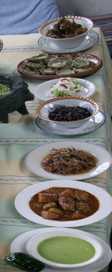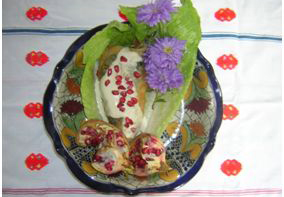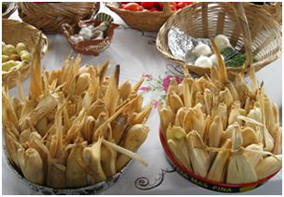 Cuisine of the City of Puebla, Mexican Cooking School
Cuisine of the City of Puebla, Mexican Cooking School
Long before there was “Mexican Cuisine” the Olmecs, Zapotecs, Totonacs, Toltecs, and Aztecs came and intermixed their cultures, customs, and kitchens. For thousands of years before the Europeans arrived, before Rome was even a village, a sophisticated cuisine was developing here. Our Mexican Cooking School, Mexican Home Cooking, explores the vast cultures involved in the building of Mexican Cuisine and the cuisine of the city of Puebla
When the Spanish came in 1619 the mixture of kitchens began. Many indigenous dishes were accepted and adapted but much more were lost.
The most common ingredients for the endless varieties of today’s “Poblano” Cuisine include tomato, onion, cinnamon, tortilla, chiles – including anchos, pasillas, mulattos and chipotles – pumpkin seeds, raisins, cloves, sesame seeds, almonds, tomatillos, oil, garlic and salt. Nearly half these ingredients arrived in the New World with the Spanish.
What is not often noted is that all the forms of “Spanish” culture came with a strong “Middle Eastern” influence due to the Moorish rule of Spain for 500 years.The influence of the Middle East and Persia are particularly apparent in the cuisine of Puebla in its use of numerous fruits and spices – such as cinnamon, ginger, sesame seeds, cloves, cumin and nutmeg.
In 1863 the French invaded putting Maximiliano on the throne and a French Court to Mexico City. Puebla took in the French adding a touch of their cuisine to ours making our sauces, soups and pastries even more complex and unique.
The real gourmet cooking here was kept in households as “Home Cooking” for special occasions; it is never found in restaurant kitchens and nearly lost to the present generation of Mexicans as the culture is changing from outside influences.
Estela’s Story
When the Spanish came to Mexico in the 1619 many native dishes were accepted and adapted but many more were lost. They came to conquer and replicate the culture and cuisine of their homeland. They had little intention of adapting Aztec cuisine with its unfamiliar forms and tastes. What is not often noted is that all the forms of “Spanish” culture came with a strong “Middle Eastern” influence due to the Moorish rule of Spain for 500 years.
The most common ingredients for the endless varieties of today’s Mexican Cuisine include tomato, onion cinnamon, tortilla, chiles – including anchos, pasillas, mulattos and chipotles – pumpkin seeds, raisins, cloves, sesame seeds, almonds, tomatillos, oil, garlic and salt. Nearly half these ingredients arrived in the New World with the Spanish.
The influence of the Middle East and Persia are particularly apparent in the cuisine of Puebla in its use of numerous fruits and spices – such as cinnamon, ginger, cloves, cumin and nutmeg.
The tradition of the recipes that Estela teaches comes from at least 5 generations in the city of Puebla. (the location of the famous battle of “Cinco De Mayo” now celebrated in the U.S.) Two of her great-grandmothers came there with Maximilian and his troops during the French invasion, married local men and stayed in Mexico. That invasion changed the cuisine in Puebla; the French influence effecting the traditional recipes in the area.
Puebla at that time still had a very special place in the culinary tradition of Mexico due to the long tradition of hospitality in the convents, their kitchens catering to the royal and church officials resting at the halfway point (Puebla) between the coast and Mexico City.
The women in Estela’s family for generations prior to her time worked as cooks for the well-to-do residents of Puebla. Estela began a classical culinary apprenticeship at the age of seven in the traditions of Mexico that still existed at that time under the tutelage of her great-grandmother, grandmother and the older women of her family.
After working in various restaurants in Mexico Estela left and spent 20 years as head chef at her family’s restaurant in San Francisco (Mill Valley), returning here 16 years ago to open her school “Mexican Home Cooking”
Today as more and more Mexico becomes a 1st world country it is losing much of its traditional culture including the richness of its culinary history, particularly the unique cuisine of the city of Puebla
Her dream has been and continues to be, to pass on not only the traditional cuisine of Puebla, which is being lost, but also the distinct and unique dishes developed by her family while cooking for the privileged class in Puebla as well as the oral history of the Puebla region and its cuisine.
Her course is unique and due to its small size she is able to format her classes to the level of her students, allowing her to present her course to novices as well as professionals. She has had students from 13 to 83 years old and also professional and private chefs.
Rick Bayless joined her for a day of mushrooming along with the staff from his Chicago restaurants.
In 2011 The “Ala Emma” show sent a crew from Channel 5 TV in Stockholm to film a class with Estela.
In 2014 Chuck Hughes , “Iron Chef” winner joined Estela in Tlaxcala to shoot a segment of his new show “Chuck’s Week off” for the U.S. and Canadian food channels.

Chiles en Nogada

Tamales


